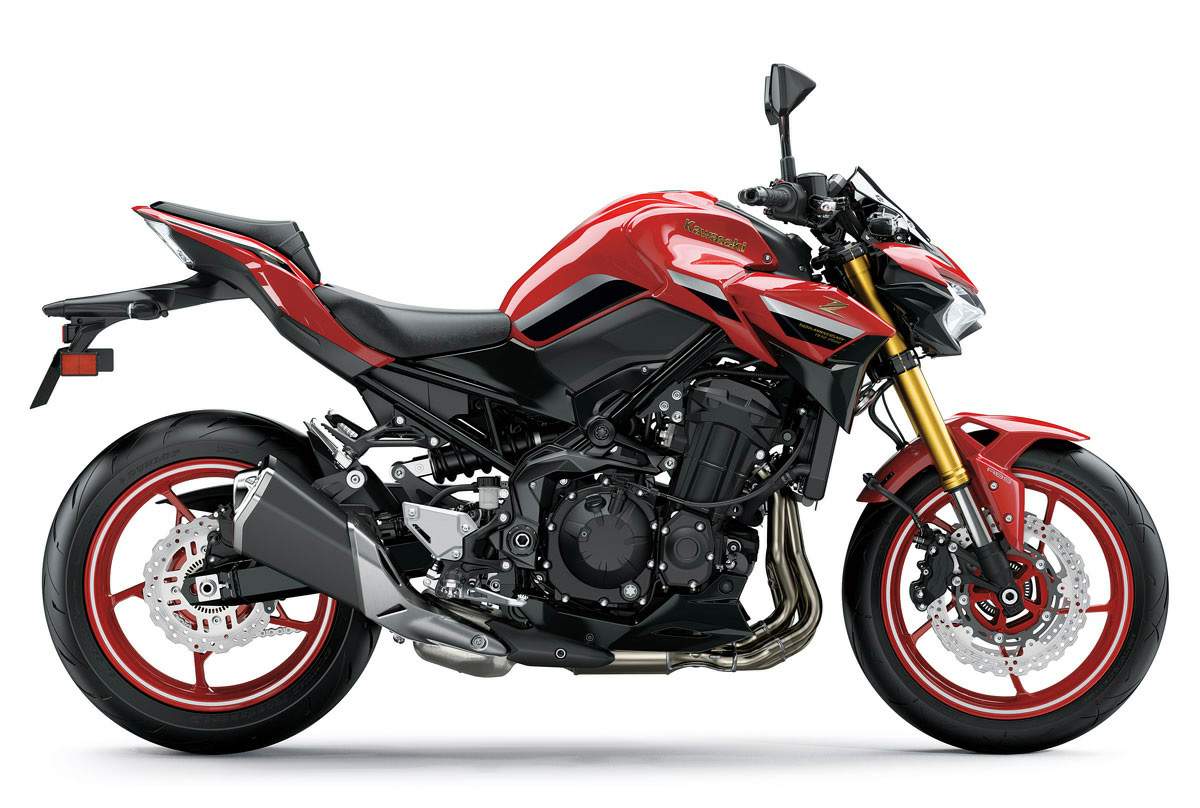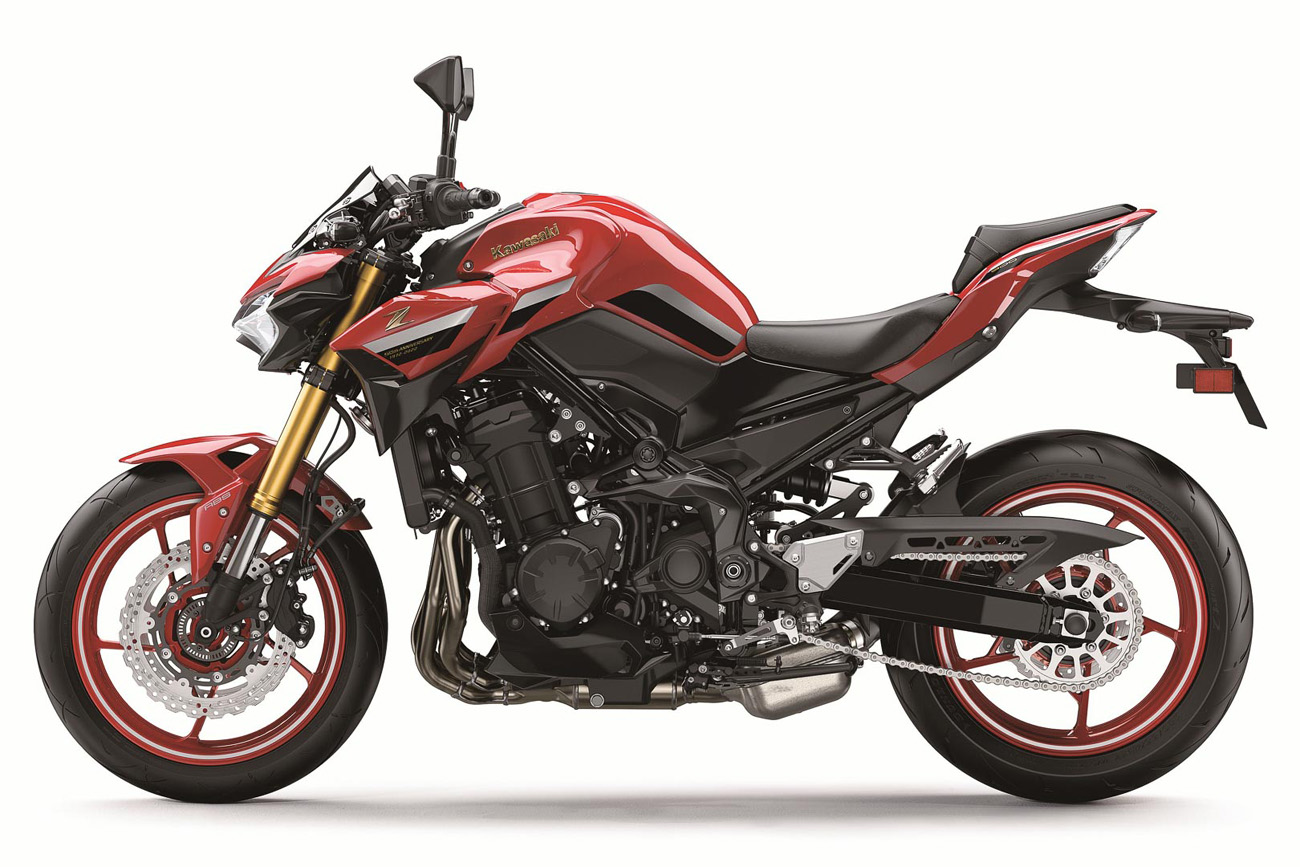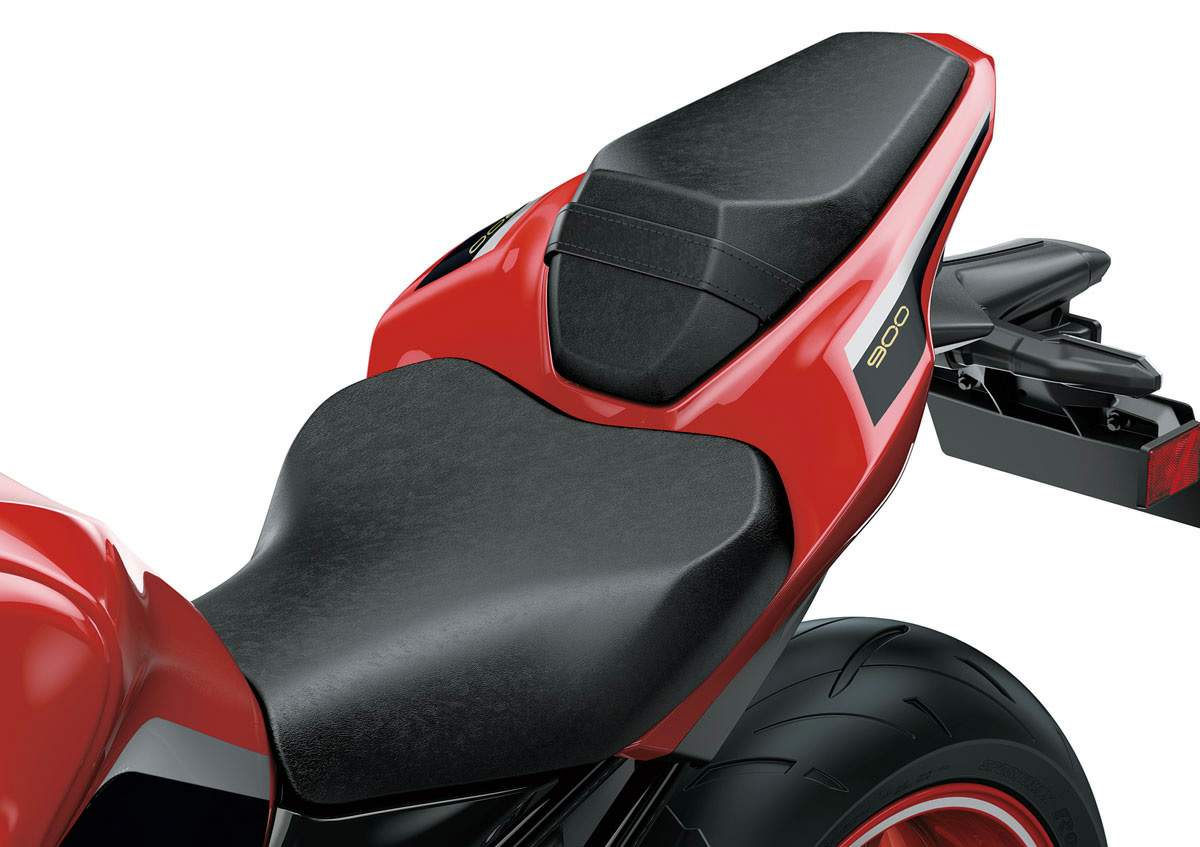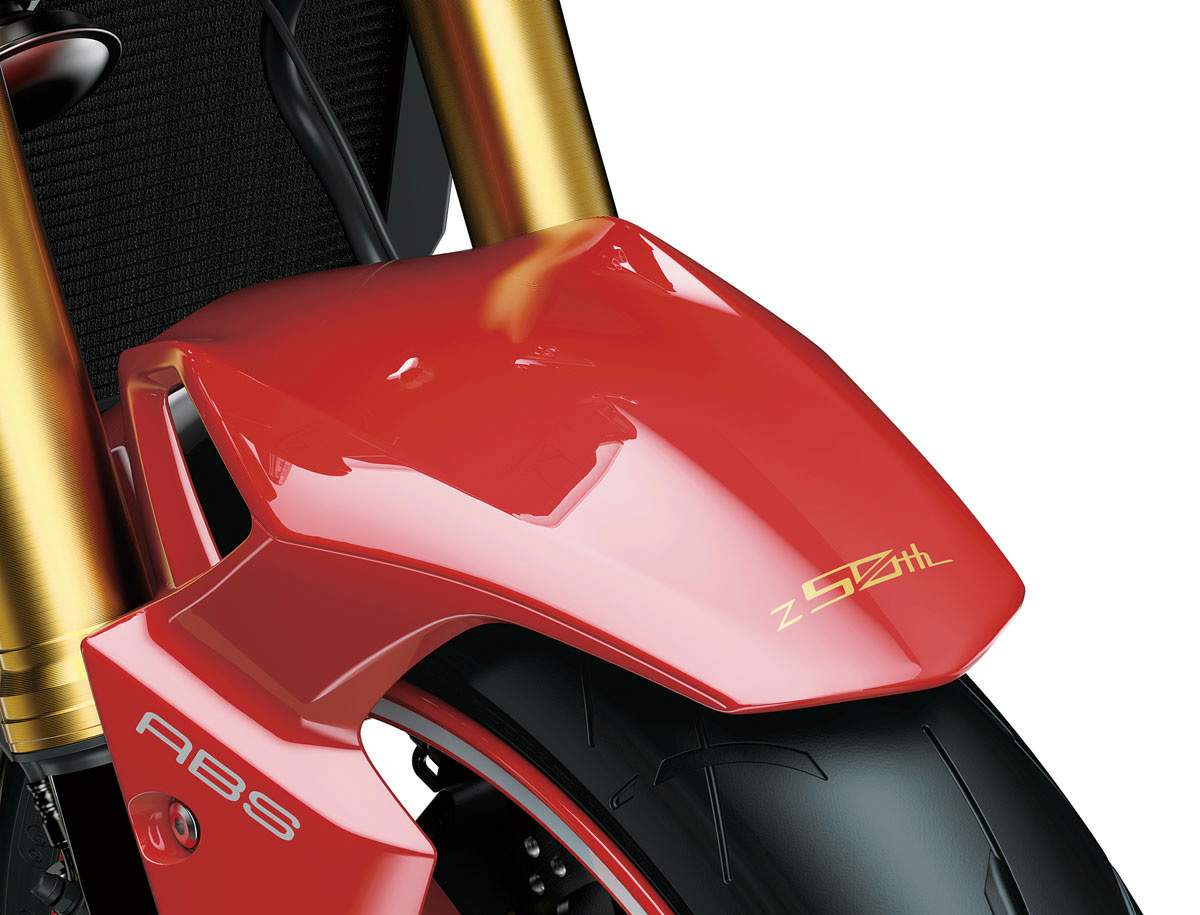
|
|
|
|
|
|
Classic Bikes
Custom Bikes
Individual
Racing Bikes AJP
AJS
Aprilia
Ariel
Avinton / Wakan
Bajaj
Benelli
Beta
Bimota
BMW
Brough Superior
BRP Cam-Am
BSA
Buell / EBR
Bultaco
Cagiva
Campagna
CCM
CF Moto
Combat Motors
Derbi
Deus
Ducati
Excelsior
GASGAS
Ghezzi Brian
Gilera
GIMA
Harley Davidson
Hero
Highland
Honda
Horex
Husaberg
Husqvarna
Hyosung
Indian
Jawa
Kawasaki
KTM
KYMCO
Laverda
Lazareth
Magni
Maico
Mash
Matchless
Mondial
Moto Guzzi
Moto Morini
MV Agusta
MZ / MuZ
NCR
Norton
NSU
Paton
Peugeot
Piaggio
Revival Cycles
Roland Sands
Royal Enfield
Sachs
Sherco
Sunbeam
Suzuki
SWM
SYM
Triumph
TVS
Ural
Velocette
Vespa
Victory
Vincent
VOR
Voxan
Vyrus
Walt Siegl
Walz
Wrenchmonkees
Wunderlich
XTR / Radical
Yamaha
Zero
Video
Technical
Complete Manufacturer List
|
Kawasaki Z 900 50th Anniversary |
| . |
|
Make Model |
Kawasaki Z 900 50th Anniversary |
|
Year |
2022 |
|
Engine |
Four stroke, transverse four cylinder, DOHC, 4 valves per cylinder |
|
Capacity |
948 cc / 57.8 cu-in |
| Bore x Stroke | 73.4 x 56.0 mm |
| Cooling System | Liquid cooled |
| Compression Ratio | 11.8:1 |
| Lubrication | Forced lubrication, wet sump |
|
Induction |
Fuel injection: 36 mm x 4 with sub-throttle |
|
Ignition |
TCBI with electronic advance |
| Starting | Electric |
|
Max Power |
92.2 kW / 123.6 hp @ 9500 rpm |
|
Max Torque |
98.6 Nm / 72.7 lb-ft @ 7700 rpm |
| Clutch | Wet multi-disc, manual |
|
Transmission |
6 Speed |
| Final Drive | Sealed chain |
| Primary Reduction Ratio | 1.627 (83/51) |
| Gear Ratios | 1st 2.692 (35/13) 2nd 2.059 (35/17) 3rd 1.650 (33/20) 4th 1.409 (31/22) 5th 1.222 (33/27) 6th 1.034 (30/29) |
| Final reduction ratio | 2.933 (44/15) |
| Frame | High-tensile steel trellis |
|
Front Suspension |
41 mm inverted fork with compression and rebound damping and spring preload adjustability |
| Front Wheel Travel | 120 mm / 4.7 in |
|
Rear Suspension |
Öhlins S46, horizontal back-link, gas-charged shock with rebound damping and spring preload adjustability |
| Rear Wheel Travel | 140 mm / 5.5 in |
|
Front Brakes |
2x 300 mm Brembo disc, Dual Brembo M4 radial-mount, monobloc, opposed 4-piston caliper |
|
Rear Brakes |
Single 250mm, 1 piston caliper |
| ABS | Standard |
|
Front Tyre |
120/70ZR17M/C (58W) |
|
Rear Tyre |
180/55ZR17M/C (73W) |
| Rake | 24.5° |
| Trail | 110 mm / 4.3 in |
| Dimensions |
Length 2070 mm / 81.4 in Width 825 mm / 32.4 in Height 1115 mm / 43.8 in |
| Wheelbase | 1455.4 mm / 57.3 in |
| Seat Height | 820 mm / 32.2 in |
| Ground Clearance | 145 mm / 5.7 in |
|
Wet Weight |
213 kg / 469.5 lbs |
|
Fuel Capacity |
17 Litres / 4.5 US gal |
| . |
Kawasaki’s legacy of creating motorcycles that have unrivaled performance, excitement, and unmatched styling continues by welcoming four new special anniversary models to its 2022 motorcycle lineup with the Z 50th Anniversary Z900, Z650 Z900RS and Z650RS.
As the last letter in the alphabet, Z represents the ultimate – the reason why the legendary Kawasaki super4 900 was nicknamed the Z1 in 1972. Since then, the Z moniker has been inherited by several models in Kawasaki’s lineup that have been developed to stand out as the ultimate machines in their respective categories. Fast forward to 2014 and the next step in Z supernaked performance and design was taken with Sugomi styling incorporated into the Z1000. The Kawasaki Z family of motorcycles has grown into one of Kawasaki’s core motorcycle brands.
For 2022, the Z 50th Anniversary editions of the supernaked Z900 and Z650 can be found adorned in a “Firecracker Red” paint scheme, similar to that found on the dominant 1981 Z1100GP that pushed the limits of air-cooled high performance. The Z brand’s 50-year pursuit of the ultimate riding excitement, passed from generation to generation, now vividly adorns these Z supernaked models.
For the Z 50th Anniversary editions of the Z900RS and Z650RS, the iconic “Fireball” colorway of the 1972 Z1 was chosen. With elegant curves resplendent in the lustrous, rich red of the famous Fireball pattern, Z's glorious past and brilliant future shines for all to see. An exquisite milestone to mark half a century of Z history.
Limited production will apply to each of these unique models and a special coffee table book commemorating the 50 years of the Z brand will be included as a premium gift for each customer who purchases a Z 50th Anniversary Edition model.

Z 50th ANNIVERSARY Z900 AND Z650
Z 50th Anniversary editions of the Z900 and Z650 supernakeds are clad in an
eye-catching “Firecracker Red” that was found on dominant Kawasaki machines like
the Z1100GP. This hue of red was Kawasaki’s signature color in the 1980s, and
for these Z 50th Anniversary models, was specially blended, making their
aggressive supernaked Z styling even more striking. Dark blue and silver
highlights throughout complement the vivid red color and a gloss black frame
contrasts the bright coloring. The Z emblem and Kawasaki logo are finished in
gold and a commemorative Z 50th Anniversary logo has been added to the front
fender, further distinguishing these models from their
standard counterparts. The red wheels feature silver pinstripes, adding to the
head turning styling and special seat that has a texture distinct from the
standard model. Gold outer fork tubes can also be found on the Z 50th
Anniversary Z900, providing a high-class touch.
Z 50th ANNIVERSARY Z900RS AND Z650RS
Reigniting the classic style of the original Z1 900 motorcycle, the Kawasaki Z 50th Anniversary Z900RS and Z650RS retro-sport motorcycles feature a “Fireball” colorway that honors the legendary Z1 and pursues the quality suitable for a 50-year milestone. A special painting process was developed specifically for these Z 50th anniversary models, which includes the candy colors being applied in layers using a special technique that brings out a deep, glossy texture to enhance the inherent beauty of these retro-sport models. The frame is finished in gloss black to complement the rich coloring, and gold colored wheels add to the old school retro styling. Additional special features found on these models include “Double Overhead Camshaft” side cover emblems like that found on the original Z1, a commemorative Z 50th Anniversary tank logo, revised seat material with a distinct texture and special color stitching, and a chrome grab bar.
Adding to the Z 50th Anniversary Z900RS’ design are timeless design elements with minimal bodywork and no fairing for a pure retro-style look.

TECHNOLOGY
Engine management
Ever since our first motorcycle engine in 1950, Kawasaki has been continually pursuing new technologies in the creation of our high-performance engines. Today, our models are filled with numerous original Kawasaki technological features that have evolved over our long history.
Based on feedback from racing activities, the Assist & Slipper Clutch uses
two types of cams (an assist cam and a slipper cam) to either drive the clutch
hub and operating plate together or apart.
Under normal operation, the assist cam functions as a self-servo mechanism,
pulling the clutch hub and operating plate together to compress the clutch
plates. This allows the total clutch spring load to be reduced, resulting in a
lighter clutch lever feel when operating the clutch.
When excessive engine braking occurs – as a result of quick downshifts (or an
accidental downshift) – the slipper cam comes into play, forcing the clutch hub
and operating plate apart. This relieves pressure on the clutch plates to reduce
back-torque and helps prevent the rear tyre from hopping and skidding. This
race-style function is particularly useful when sport or track riding.
Superior Suspension
The large-diameter gold-colored inverted fork with greater adjustability is complemented by a Öhlins S46 rear shock for increased ride comfort and a superior sense of grip and handling. The rear suspension is also equipped with a remote preload adjuster, which makes it easy to adjust settings without tools to suit tandem riding or luggage.
Horizontal Back-link Rear Suspension
Horizontal Back-link Rear Suspension arranges its shock unit horizontally, greatly contributing to efficient use of space and mass centralisation.
Compared to Kawasaki's traditional Uni-Trak rear suspension, which mounts the shock unit vertically, with Horizontal Back-link rear suspension, the shock unit is almost horizontal. Kawasaki's original suspension arrangement locates the shock unit very close to the bike's centre of gravity, greatly contributing to mass centralisation. And because there is no linkage or shock unit protruding beneath the swingarm, this frees up space for a larger exhaust pre-chamber (an exhaust expansion chamber situated just upstream of the silencer). With a larger pre-chamber, silencer volume can be reduced, and heavy exhaust components can be concentrated closer to the centre of the bike, further contributing to mass centralisation. The result is greatly improved handling. Another benefit is that the shock unit is placed far away from exhaust heat. Because it is more difficult for heat from the exhaust system to adversely affect suspension oil and gas pressure, suspension performance is more stable. Horizontal Back-link rear suspension offers numerous secondary benefits like this.

Brembo Brakes
The front brake package with Brembo components offers stronger stopping power and contributes to even more precise control and greater ease of use. The ø300 mm Brembo front discs and M4.32 radial-mount monobloc calipers are complemented by a Nissin radial-pump master cylinder with stainless-steel braided lines to deliver greater stopping power and a more linear progression when operating the brake lever.
ABS
ABS (Anti-lock Brake System) ensures stable braking performance by preventing wheel lock during braking.
Sudden over-application of the brakes, or braking on low-grip surfaces (surfaces with a low coefficient of friction) such as wet asphalt or manhole covers may cause a motorcycle's wheel(s) to lock up and slip. ABS was developed to prevent such incidents. Kawasaki ABS systems are controlled by high precision and highly reliable programming formulated based on thorough testing of numerous riding situations. By ensuring stable braking performance, they offer rider reassurance that contributes to greater riding enjoyment. And to meet the special requirements of certain riders, specialised ABS systems are also available. For example, KIBS (Kawasaki Intelligent anti-lock Brake System) is a high-precision brake system designed specifically for supersport models, enabling sport riding to be enjoyed by a wider range of riders. And by linking the front and rear brakes, K-ACT (Kawasaki Advanced Coactive-braking Technology) ABS provides the confidence to enjoy touring on heavyweight models. Kawasaki is continually working on the development of other advanced ABS systems.
New Tyres
New Dunlop Sportmax Roadsport 2 tyres contribute to the Z900’s handling character.
Assist & Slipper Clutch
Based on racing technology, the Assist & Slipper Clutch acts as both a back-torque limiter and a self-servo mechanism that enables a lighter clutch lever pull.
KTRC (3-MODE)
Ever since our first motorcycle engine in 1950, Kawasaki has been continually pursuing new technologies in the creation of our high-performance engines. Today, our models are filled with numerous original Kawasaki technological features that have evolved over our long history.
3-Mode KTRC (Kawasaki TRaction Control), Kawasaki's most advanced traction control system, offers a selection of modes to suit a variety of riding situations, from sport riding to touring.
3-mode KTRC combines the traction control technology of both 1-mode KTRC, which provides enhanced stability in slippery situations by preventing wheel slip, and S-KTRC, which helps maintain optimum traction in sport riding situations by predicting the rear wheel slip ratio during acceleration, into a single system.
The convenient handle switch allows the type of traction control to be changed instantly by selecting one of the three modes, even while riding. Modes 1 and 2 maintain optimum traction during cornering, like S-KTRC. Designed with sport riding in mind, they enable sharp acceleration out of corners by maximising forward drive from the rear wheel. Modes 1 and 2 differ in the amount that they intervene. Mode 1, set for dry, good-grip road conditions, maintains the ideal slip ratio to ensure optimum traction.
Mode 3 operates like 1-mode KTRC, reducing power to allow grip to be regained when rear wheel spin is detected. It is ideal when riding in slippery conditions or in the wet. Enabling riders to easily change traction control character, 3-mode KTRC is Kawasaki's most advanced engine management system.

Power Modes
Power Mode selection allows engine power delivery to be changed to suit the riding situation.
Models equipped with multiple Power Modes offer riders an easily selectable choice of engine power delivery to suit riding conditions or preference. In addition to Full Power mode, one (Low) or two (Middle, Low) alternate mode(s) in which maximum power is limited and throttle response is milder are provided.
Dual Throttle Valves
Dual Throttle Valves offer increased power and greater ease of use care of a second set of ECU-controlled throttle valves.
Late-model sport bikes often use large-bore throttle bodies to generate high
levels of power. However, with large diameter throttles, when a rider suddenly
opens the throttle, the unrestricted torque response can be strong. Dual
throttle valve technology was designed to tame engine response while
contributing to performance.
On models with dual throttle valves, there are two throttle valves per cylinder:
in addition to the main valves, which are physically linked to the throttle grip
and controlled by the rider, a second set of valves, opened and closed by the
ECU, precisely regulates intake airflow to ensure a natural, linear response.
With the air passing through the throttle bodies becoming smoother, combustion
efficiency in improved and power is increased.
Economical Riding Indicator
The Economical Riding Indicator is a mark appearing on the instrument panel to indicate favourable fuel consumption, encouraging fuel efficient riding.
Using high-precision electronic control for engine management, Kawasaki models can achieve a high level of fuel efficiency. However, fuel consumption is greatly affected by throttle use, gear selection, and other elements under the rider's control. The Economical Riding Indicator is a function that indicates when current riding conditions are consuming a low amount of fuel. The system continuously monitors fuel consumption, regardless of vehicle speed, engine speed, throttle position and other riding conditions. When fuel consumption is low for a given speed (i.e. fuel efficiency is high), an "ECO" mark appears on the instrument panel's LCD screen. By riding so that the "ECO" mark remains on, fuel consumption can be reduced. While effective vehicle speed and engine speed may vary by model, paying attention to conditions that cause the "ECO" mark to appear can help riders improve their fuel efficiency – a handy way to increase cruising range. Further, keeping fuel consumption low also helps minimise negative impact on the environment.
All-LED Lighting
New LED headlamp, position lamps, licence plate lamp and turn signals† add to the Z900’s sharper new styling.
Smartphone connectivity
Smartphone connectivity contributes to an enhanced motorcycling experience by enabling riders to connect to their motorcycle wirelessly.
Clever technology enables riders to connect to their motorcycle wirelessly. Using the smartphone application “RIDEOLOGY THE APP,” a number of instrument functions can be accessed, contributing to an enhanced motorcycling experience. Vehicle information (such as the odometer, fuel gauge, maintenance schedule, etc) can be viewed on the smartphone. Riding logs (varies by model, but may include GPS route, gear position, rpm, and other information) can be viewed on the smartphone. When connected, telephone (call, mail) notices are displayed on the instrument panel. Riders can also make changes to their motorcycle’s instrument display settings (preferred units, clock and date setting, etc) via the smartphone. And on certain models, it is even possible to check and adjust vehicle settings (such as Rider Mode, electronic rider support features, and payload settings) using the smartphone.
Latest Evolution of Z Sugomi Styling
While the Z900’s distinctive sugomi design elements (crouching stance, low-positioned head and upswept tail) remain unchanged, its eye-catching styling benefits from a number of updates that make its aggressive design even sharper.
|
Any corrections or more information on these motorcycles will be kindly appreciated. |